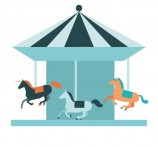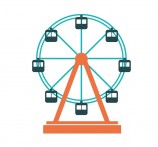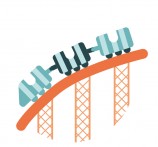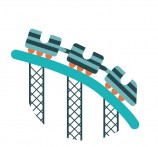1. Carousel

Few things are more synonymous with fair grounds and theme parks than the carousel. Invented by New York master carver Charles I.D. Looff in 1876, who attached his carved wooden animals on to a moving circular platform, the carousel may lack the speed and technology of most modern attractions, but is still beloved by visitors of all ages around the world.
2. Ferris wheel

In 1893 organisers of the Chicago World’s Fair issued a challenge to create an attraction that would overshadow the grandeur of the Eiffel Tower in Paris, which had hosted the World’s Fair four years earlier. While Gale Ferris Jr only managed to build a 264ft wheel, dwarfed by Gustave Eiffel’s 1,063ft iron behemoth, it carried 36 cars holding up to 60 people, giving an impressive total capacity of 2,160. What’s more, the Ferris wheel would go on to become a mainstay of theme parks the world over for the next century.
3. Wooden coaster

While not the first wooden coaster to be built, Leap-The-Dips at Lakemont Park in Pennsylvania today stands as the world’s oldest operating ride of its kind. Built in 1902 by the E. Joy Morris Company, the ride was forced to close in 1985 due to disrepair, but a successful fundraising campaign led to its restoration in 1999. Standing at a mere 41ft, the ride is quite tame by modern standards, but has been named a national historic landmark and is still bringing in crowds to this day.
4. Steel coaster

Matterhorn Bobsleds was a revolution in rollercoaster design. Disneyland introduced the world’s first tubular steel coaster in 1959 which meant, unlike conventional wooden rails, the track could be bent in any direction, paving the way for the loops and corkscrews that we know today. It is said that Walt Disney’s original concept was to give guests the experience of tobogganing down a snowy hill.
5. Immersive storytelling

A 1960s indoor boat ride with singing dolls doesn’t sound like much, but It’s A Small World at Disneyland in California remains one of the park’s most revered attractions. Featuring more than 300 audio-animatronic dolls in traditional costumes from around the world, singing an annoyingly catchy theme song, the ride was originally created as a tribute to the UNICEF 1964 New York Fair, but became a huge hit and moved to Disneyland where it is still going strong.
6.Dark rides

Dark rides have been around for years, such as the first 1930s ghost train at Blackpool Pleasure Beach or the ubiquitous Tunnel of Love of yesteryear, but they really came into their own in the late-1960s. Disneyland’s
Adventure Thru Inner Space was the first attraction to use the patented Omnimover system, with rotating pods that control line of sight and animation showing riders what’s it’s like to be shrunk down to the size of an atom. Though the latter closed in 1985, Florida Disney World’s popular shooting-gallery game, Buzz Lightyear’s Space Ranger Spin, still uses the same system, with riders able to spin around in their carriages while firing infrared lasers to help Buzz in his battle to defeat the evil Emperor Zurg.
7. Inverted coaster

Magic Mountain and Cedar Point have been battling it out for the crown of “rollercoaster world capital” for four decades, ever since they competed to build the modern looping coaster in 1976. Magic Mountain pipped Cedar Point to the post by just a week with the creation of the single-inversion coaster Revolution, though the latter’s corkscrew includes both a vertical loop and double-corkscrew. Full Throttle at Six Flags Magic Mountain in California, however, currently stands as the ride with the tallest loop at over 127ft.
8. Trackless attractions

Pooh’s Hunny Hunt in Tokyo Disneyland, while not one for thrill-seekers, was a groundbreaking trackless dark ride built in 2000. Based on the Winnie the Pooh children’s books, the ride uses a unique “local positioning system”, enabling computers to move each carriage from room to room, following Pooh and his friends in their search for honey in the Hundred Acre Wood. Adrenaline junkies may well steer clear, but Pooh’s Hunny Hunt is Fantasyland’s most popular attraction.
9. Multi-sensory

Multi-sensory attractions were the inevitable next step in theme park evolution, using advanced technology for a fully immersive thrill ride. The Amazing Adventures of Spider-Man at Universal Orlando is one such attraction, submerging visitors in a 3D virtual reality where they follow the comic book hero in a moving car through city streets and over buildings, including a simulated 400ft freefall. Journey to the Centre of the Earth, the 2001 dark ride inspired by the Jules Verne novel, is also noteworthy. The Toyko DisneySea attraction transports visitors on a mining carriage through caverns, mushroom forests and earthquakes into the heart of Mount Prometheus, using light, sound, heat and motion for a complete, multi-sensory experience.
